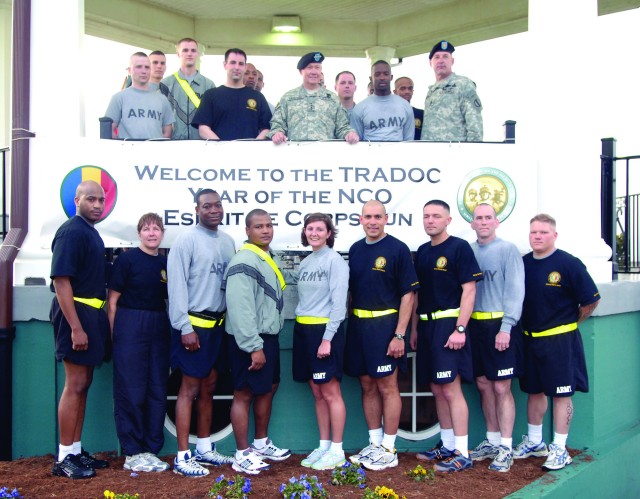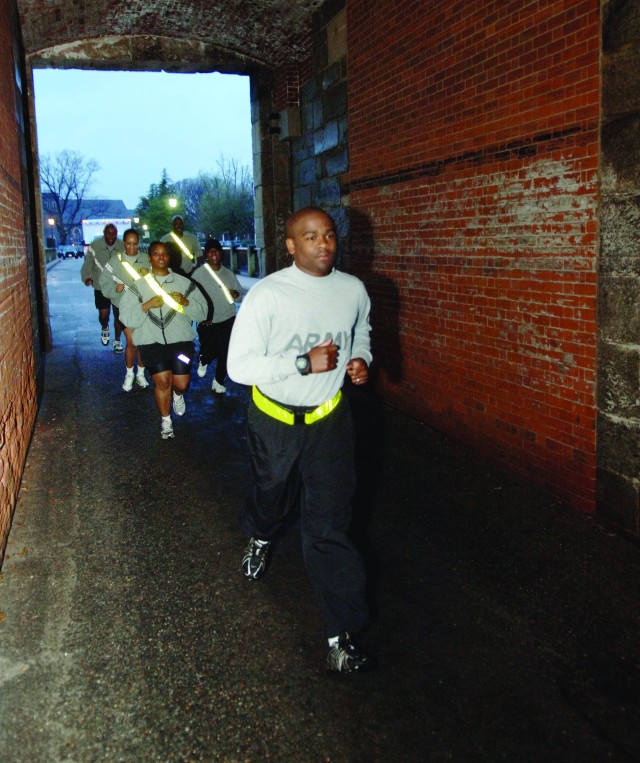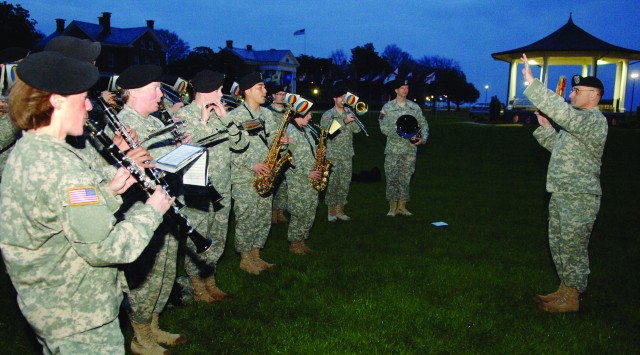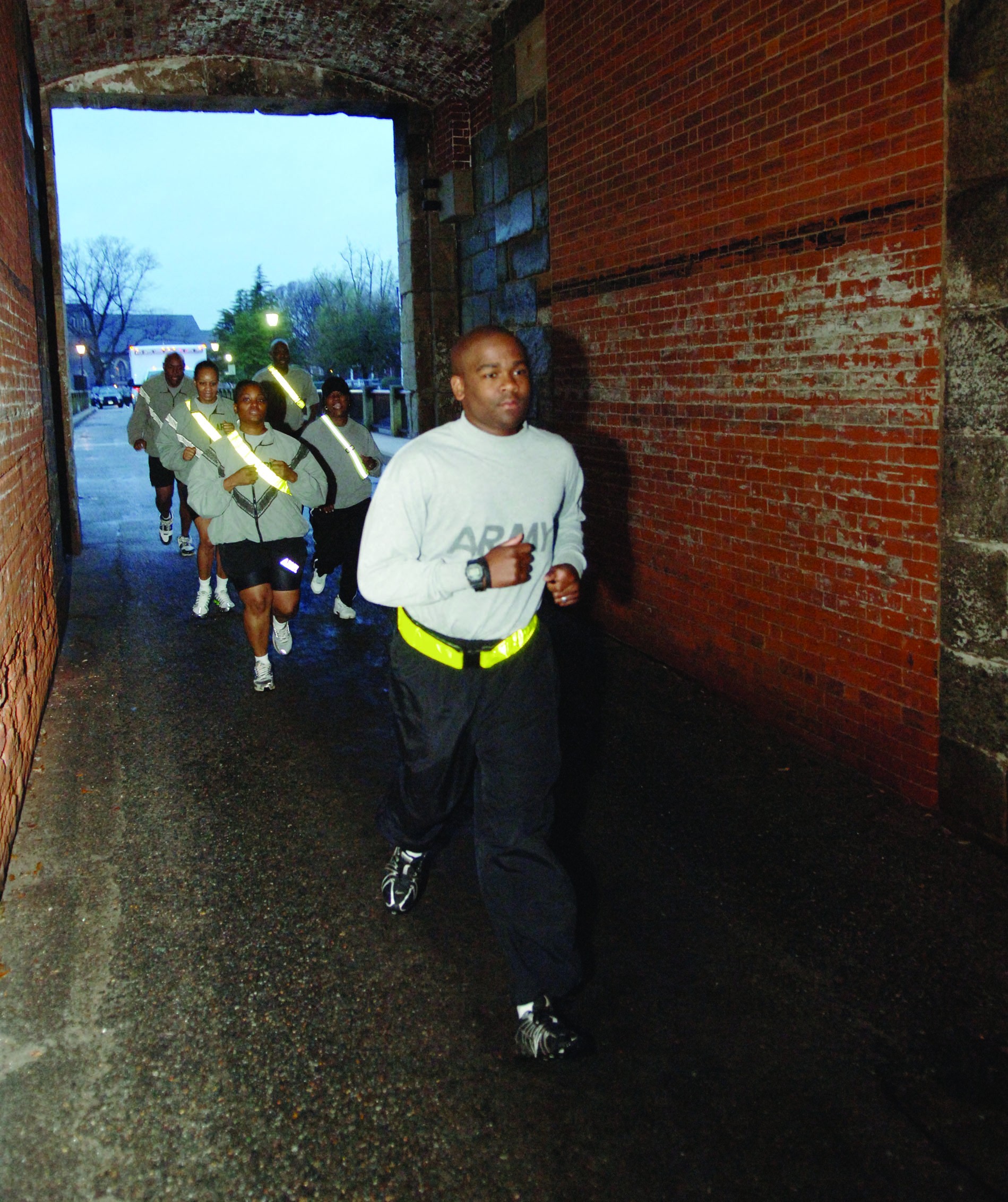FORT MONROE, Va. - About 200 Soldiers, civilians and family members participated in the NCO Day celebration here April 3. The event included a fun run and a briefing at the installation's Bay Breeze Community Center featuring guest speakers like Lt. Gen. David P. Valcourt, Deputy Commanding General for U.S. Army Training and Doctrine Command.
The early morning fun run started at Continental Park, and the 3.36-mile route wound through the inner fort and along the seawall. Two TRADOC Band ensembles played motivational music - one was located near the Casemate museum and the other at the start/finish line.
Gen. Martin E. Dempsey, TRADOC Commanding General, stopped by to present award plaques to the two fastest runners - Sgt. 1st Class Roland Pane, TRADOC G-1/7, and Col. Linda Sheimo, TRADOC G-1/4. Those Soldiers and 18 other "runners up" were given a commanding general's coin.
Later that morning at the BBCC brief, Lt. Gen. Valcourt recalled his earlier days as an artillery officer and those times when he would lay awake at night wondering if his troops would "keep rounds on target" without his supervision. "I was beating myself up over nothing. Those NCOs I left in charge were trained and certified to do the job right, but I didn't place my trust in them. That's the way the Army was back then, but we've come a long way.
"Today, we recognize the enormous value of our NCO corps, and we won't even hesitate in sending them downrange to take care of business. It's almost taken for granted because it's such a common element of everyday operations."
The DCG also highlighted the role of NCOs in every facet of military life. "Think about it ... the first handshake a civilian entering the Army receives is that of an NCO. They're the first-line trainers from schoolhouse to duty section. And any Soldier who successfully reaches retirement will tell you that they got there because of the support of one or several NCOs. From cradle to grave, the success of the Army Soldier is in the hands of our noncommissioned officers."
A very exciting future awaits current and future hard-stripers, the lieutenant general also noted. Greater leadership roles and responsibilities are certain, he said. Further enhancements to leader development schools are "in the works," and service leaders are fully engaged in programs that will improve every Soldier's quality of life.
"That's the message that your senior leaders are bringing to you. We owe you this recognition. As far as I'm concerned, every year should be the Year of the NCO."
The briefing continued with a history of the NCO Corps presentation by Sgt. 1st Class Michael Noland, the 2008 U.S. Army Drill Sergeant of the Year. He was followed by Sergeants 1st Class Michael Bowman and Allen Snider from the Transportation Corps Noncommissioned Officers' Academy at Fort Eustis. They discussed the significance of each NCO rank and the increase in duties and responsibilities as a Soldier earns each additional stripe.
Next, Sgt. Maj. Chris Camacho from the Office of the Deputy G-7 for Futures (TRADOC G-3/5/7) offered a quick overview of the changes that are occurring within the Noncommissioned Officer Education System (NCOES). Most notable is the new training focus - more emphasis is being placed on the leadership skills needed for "full spectrum operations," as identified in the Army's new FM 3-0 field manual.
Names are also changing: the old "primary leadership course," or PLDC, has become the "Warrior Leadership Course;" the Basic and Advanced NCO Courses will follow suit as the Advanced and Senior Leadership Courses, respectfully. TRADOC is working on the Web-based delivery of the current BNCOC Common Core curriculum, Sgt. Maj. Camacho noted. Implementation is projected for FY2010.
"The command is looking at a six-day training schedule throughout NCOES to create more time for instruction while minimizing the time away from home station as much as possible," he continued. "And we're adjusting our method of migrating content down to Soldiers so they will have access to appropriate leadership development instruction before they assume a position, rather than afterward, which is often the case now."
The final speaker of the day was TRADOC Command Sgt. Maj. David M. Bruner. He acknowledged the significant contributions of recruiters, retention NCOs, and the Reserve and Guard forces that have become an integral component of the tactical Army. Then he focused his attention on the command, admitting that he never fully understood the true importance of its mission early on in his career.
"Now I'm here, and I see it every day. People like you - planners and trainers - rolling up your sleeves and giving your blood to those Soldiers who will be heading out there to fight the fight," he said. "That's what it's all about, and as far as I'm concerned, every NCO in the Army should complete at least one tour in TRADOC to experience its role in the operational Army."
"Inner-reflection" should be another byproduct of the Year of the NCO observance, according to the command sergeant major. Regardless of rank, the Army sergeant should set the example when it comes to issues like safety, sexual assault awareness and prevention, mental health, volunteerism and so forth. "Doing the right thing is not a switch you can turn off and on," he said. "If you're not (supporting Army programs) here at home, why should we trust that you'll do it when you're downrange'"
"Spectacular" was one of the words Staff Sgt. Okechukwu Achigbu from U.S. Army Accessions Command used to describe the overall NCO Day observance. "It was a great honor to share this day with fellow NCOs," he said. "The kickoff run was motivating. It was a good idea to allow friends and family (his 8-month-old son was there) to share the moment; that made it even more memorable.
Of the day's messages, the staff sergeant said the "cradle to grave" comment by the TRADOC DCG meant the most to him. "I can relate to the grave part of it because I have participated in military funeral details in the past. And he was on target with the cradle comment because NCO duties include the training of future Soldiers and officer leaders."
Born in Nigeria, Achigbu now calls Fayetteville, N.C., home. He is the administrative NCO in the Secretary of the General Staff Officer at USAAC. "This is my year, I'm proud to serve," he said.
Sgt. 1st Class Shawn Herzog, a master driver assigned to the Army Capabilities Integration Center here, said the Year of the NCO observance is "long overdue," and he very much appreciates the extra recognition it is bringing to the "backbone of the Army."
"I thought the NCO Day here was well organized, very professional and truly enjoyed by (everyone who participated)," he said. "The thing I enjoyed the most was the professional development session because of the wide range of information it offered and the opportunity to meet other NCOs that you don't see on a daily basis.
"It was exciting to hear about the planned changes to the NCO Education System as well," the 16-year veteran from Long Island, N.Y., said. "Overall, the camaraderie and motivation from the beginning of the day to the end was outstanding, and I was glad to be a part of it."






Social Sharing